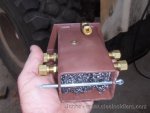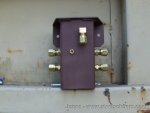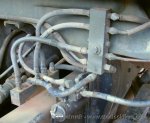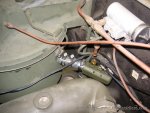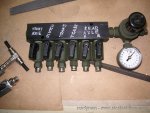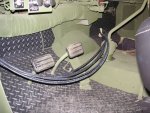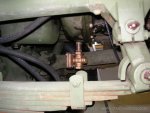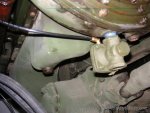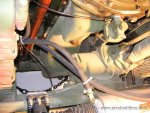Jones
Well-known member
- 2,237
- 83
- 48
- Location
- Sacramento, California
Problem: Venting axles and gearboxes.
At some point the military came up with a positive pressure system to exclude water from entering axles and gearboxes during fording operations. Effective but complicated and prone to clogging and air leaks; and sometimes a vehicle just doesn't need that level of protection. Plus, if I'm in water deep enough to submerge my transfer case I'm gonna be more worried about stumbling onto a hidden snag or a drop-off in the river bottom than a leaking seal.
Came up with this idea for a simple but effective way to vent drive train and air brake components.
I made a 'birdhouse' out of a piece of box tubing and an angle flange that I bent up out of sheet metal. Holes drilled and tapped into the body accept fittings which connect to similar ones on axles or gearboxes. 3/8" lines and fittings will more than deal with any vacuum momentarily created by submerging a warm axle in cold water. In the case of the baby HEMTT, and later 5 tons and up, I also have the vent side of full air brake cans that need to breathe as brakes are applied and released; thus the two lines per side-- one for each brake can. The single fitting is for the axle itself.
Using the holes drilled through the flange sides, these vent assemblies can be bolted to frame, underside of bed-- any spot high enough to keep them from ending up underwater. The idea is to mount them with the open end down so that rain or splashed water will immediately drain out.
To keep wasps and other nestbuilders from plugging up the works, I put a piece of steel mesh pot-scrubber material in the open end and secured it with a cotter pin. It this clogs up you can just remove the cotter pin, pull out and rinse the 'filter' and reassemble. The idea behind using metal mesh was so that wasps or hornets wouldn't be able to chew their way through it. Fine-mesh (1/8" openings) hardware cloth will do just as well; as long as it's metal and not nylon screen.
At some point the military came up with a positive pressure system to exclude water from entering axles and gearboxes during fording operations. Effective but complicated and prone to clogging and air leaks; and sometimes a vehicle just doesn't need that level of protection. Plus, if I'm in water deep enough to submerge my transfer case I'm gonna be more worried about stumbling onto a hidden snag or a drop-off in the river bottom than a leaking seal.
Came up with this idea for a simple but effective way to vent drive train and air brake components.
I made a 'birdhouse' out of a piece of box tubing and an angle flange that I bent up out of sheet metal. Holes drilled and tapped into the body accept fittings which connect to similar ones on axles or gearboxes. 3/8" lines and fittings will more than deal with any vacuum momentarily created by submerging a warm axle in cold water. In the case of the baby HEMTT, and later 5 tons and up, I also have the vent side of full air brake cans that need to breathe as brakes are applied and released; thus the two lines per side-- one for each brake can. The single fitting is for the axle itself.
Using the holes drilled through the flange sides, these vent assemblies can be bolted to frame, underside of bed-- any spot high enough to keep them from ending up underwater. The idea is to mount them with the open end down so that rain or splashed water will immediately drain out.
To keep wasps and other nestbuilders from plugging up the works, I put a piece of steel mesh pot-scrubber material in the open end and secured it with a cotter pin. It this clogs up you can just remove the cotter pin, pull out and rinse the 'filter' and reassemble. The idea behind using metal mesh was so that wasps or hornets wouldn't be able to chew their way through it. Fine-mesh (1/8" openings) hardware cloth will do just as well; as long as it's metal and not nylon screen.
Attachments
-
39.5 KB Views: 784
-
30.1 KB Views: 783



